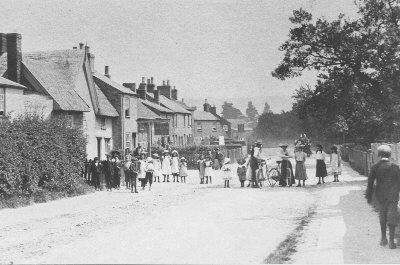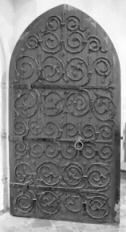The Village of Eaton Bray
Posted on October 23, 2008
The village of Eaton Bray sits at the foot of the Dunstable Downs and was once known as Eitone, or 'place of water' due to the large number of natural springs in and around the village.
Eitone is mentioned in the Doomsday Book of 1086, after the invasion by William the Conqueror, the manor of Eitone is given to his half brother Odo Bishop of Bayeux. Odo was to rule England when William was in Normandy. He commissioned the Bayeux Tapestry, which shows Odo and William talking just before the battle of Hastings. Later William and Odo quarrel and Odo is put in prison for plotting against William, and the manor reverts back to the crown.

The manor passes from Plantagenet Henry II (1154) to his Queen Eleanor of Aquitaine. Legend states that she and her children had plotted against the King, and as a punishment were kept at Etione from 1173-85.
On Eleanor's death William Cantelupe bought the manor for 300 marks in 1205. A Norman by birth, William soon turned his attention to his new aqusision and started to enlarge the existing small church and build himself a fine new castle.
However the church had been given to an Augustine Priory, at Merton in Surrey. On learning this William, having already started work on the church, took advice from the Abbot of St. Albans. He stopped work and changes his plan, obtaining permission to include a chapel in his castle.
If visiting St. Mary's church note the wonderful arcading, this being the work of William Cantilupe and dates from the early 13th century.
William was a great baron and politically important he was one of the barons who extorted the Magna Carta from King John.
William begins building a large castle, the earthworks and moats are still visible to day. The castle is described in the annuals of Dunstable as being a serious danger to the town and the neighbourhood. The extent of the castle in 1274 is described as - enclosed with moats and two drawbridges and a gatehouse. There is a hall with two chambers, a pantry, buttery, and a large chamber with galleries, a good granary and stabling for 60 horses.
The Manor remained in the possession of the Cantilupes and their descendents, the de la Zouch's, until the Wars of the Roses. When the 7th Lord John de la Zouch had the misfortune of supporting the wrong side when the armies of Richard III and Henry Tudor clashed at the battle of Bosworth in 1485.
Henry Tudor was crowned Henry VII and gave the manor to his own supporter Reginald Bray, who was with William Stanley when he picked up Richards crown and placed it on Henry Tudor's head.
Reginald Bray is knighted soon afterwards and Eitone becomes Eaton Bray. Sir Reginald was a respected statesman and architect and soon turns his attention to his new church by adding a clearstory and lady chapel.
 The church has wonderful 13th century ironwork on the south door, which is attributed to John of Leighton who was also responsible for work in St. George's chapel Windsor. Eaton Bray church is described as one of the finest parish churches in England.
The church has wonderful 13th century ironwork on the south door, which is attributed to John of Leighton who was also responsible for work in St. George's chapel Windsor. Eaton Bray church is described as one of the finest parish churches in England.
 The tomb of Lady Bray rests to the left of the high alter. A brass hanging on the wall shows her in a fashionable 'Paris' headdress with her 10 daughters and one son! [More informaton about the church is available on the St Mary's Virtual Tour.]
The tomb of Lady Bray rests to the left of the high alter. A brass hanging on the wall shows her in a fashionable 'Paris' headdress with her 10 daughters and one son! [More informaton about the church is available on the St Mary's Virtual Tour.]
Sir Reginald builds himself a fine manor house on the site of the now ruined castle; the house was demolished in the late 18th century. Reginald Bray was responsible for the design and rebuilding of St. George's Chapel Windsor and is buried there in the Bray Chapel. By the mid 16th century the main part of family dies out with the death of John Bray.
After the dissolution Henry VIII gives St. Mary's Church to Trinity College Cambridge, and it remained under their jurisdiction until 1938 when the living passed to St. Albans board of patronage.
The village like many others in Bedfordshire relied for employment on agriculture, straw plaiting for the hat trade and the growing of Prune plums.
Upon the arrival of The Wallace family in the latter part of the 19th century, the village again changed. The family became successful carnation growers, and provided employment until after WW2. They were great benefactors to the Church, with the alter rodeos and stained glass east window being donated by the family. They also took a keen interest in village life with Mrs Wallace forming the 1st Eaton Bray Boy Scouts troop.
Present Eaton Bray is a lively vibrant village, with many activities ranging from sports through to an annual pantomime and a monthly film club also a Sunday lunch club for older single folk. There is a flourishing WI, many church activities, and a busy village hall, which has been recently refurbished and now proudly boasts of a high tech sound and light system, projector with a large screen. All due to an enthusiastic group of village volunteers have raised funds for this with the support and grants from the Parish Council, SBDC and County Council.
Based on the text of an article written for the Bedfordshire Matters publication.
The Eaton Bray Millenium Book contains further historical infomation including how the village changed between 1900 and 1999 - Eaton Bray - A Century of Change.
Comment on This Article:
All HTML, except <i>, <b>, <u> will require your comment to be moderated before it is publicly displayed.
If you would like your own avatar displayed, read about comment avatars.
Reader Comments
Skip to form
February 23, 2009
,Bruce Smith says:Greetings from Syresham in Northants.
I am an enthusiast on Welsh Drovers' routes, and I believe there was one through Eaton Bray. Is there anyone in the village who might know more?
My phone is 01280 851037
Best wishes
Bruce
February 25, 2010
,susan odell says:Is it possible for me to purchase the book Eaton Bray, A century of Change
April 10, 2012
,betty jefferson says:My mum woked at wallaces jessie powell. my cousin janet james still lives in the village daughter of my uncle edwin
April 21, 2019
,Brian Watson says:I am tracing some distant relatives and found a large family whose father was Joseph Goodman who in the 1871 census was living in Chapel Street, Eaton Bray. This no longer appears on maps but was adjacent to 'Comp Road' on this census.
Does anyone know whether this road was renamed or what became of it please?
Thanks to anyone who can help.
Brian Watson